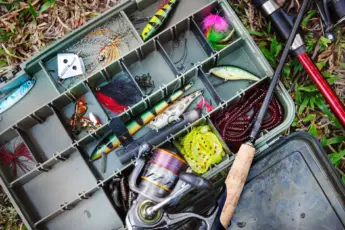There is a common misconception that catfish are strictly freshwater fish. In coastal Georgia, South Carolina, and North Carolina, two species of catfish are prevalent. Anglers catch saltwater catfish regularly in these three states. Despite the two species living amongst each other, each has unique characteristics. Here is what you need to know about a hardhead catfish vs. a gafftopsail catfish.
Hardhead Catfish
The hardhead is along the east coast of the United States. Anglers catch a significant of hardheads when fishing the bottom.
What Is The Range Of A Hardhead Catfish
When it comes to range, the hardhead is widely distributed. Anglers catch the species as far north as New England but more frequently between Maryland and Florida.
What Is The Habitat Of A Hardhead Catfish
It is unlikely to find hardheads offshore of the Atlantic ocean except for the waters off the beaches.
The hardhead catfish prefers soft mud or sand bottoms along the coast, rivers, and brackish waters.
How To Identify A Hardhead Catfish
When it comes to identifying a hardhead, they are easy to distinguish from a gafftopsail catfish. The upper half of the sides and top range between gray and black depending on the habitat. The belly of the hardhead is silver to white.
When removing the hook, look closely at the mouth. Barbels extend from the bottom lip. Lastly, the condensed tail is deeply forked.
How Big Do Hardhead Catfish Grow
The hardhead catfish exceeds three pounds; however, it is most frequently caught between half a pound and a pound in weight. When comparing hardhead to other saltwater catfish, the hardhead is of a small size.
How Do You Catch Hardhead Catfish
Hardheads are not picky eaters. Catfish are bottom dwellers; therefore, you must present the bait on the seafloor.
When targeting hardhead, rig a hook beneath a lead weight heavy enough to hold the bottom. Tip the hook with shrimp, squid, cut fish, or chicken, and allow the bait to soak until the fish strikes. Rember to focus on soft seabeds, including sand and mud.
Are Hardhead Catfish Good To Eat
When filleting and eating catfish, the hardhead produces good fillets but is rarely eaten due to its size. The yield is minuscule.
Is A Hardhead Catfish Poisonous
Unfortunately, the dorsal and pectoral fin is covered in a protective slime. The slime layering assists in keeping fish out of harm’s ways. However, the slime results in anglers becoming stung by catfish.
The dorsal and pectoral fin are sharp. Avoid touching the and upper and lower fins when handling the catfish. What is most important is understanding that a venomous slime coats the fish. When the skin becomes punctured by a fin, the slime injects into the skin, causing extreme pain to the person handling the fish.
Gafftopsail Catfish
Despite the similarities, gafftopsail catfish differ from hardheads in many ways. Here is what to know about the gafftopsail catfish.
What Is The Range Of A Gafftopsail Catfish
The range of Gafftopsial catfish is the same as the hardhead. Gafftopsails extend between Florida and the northeast; however, they are less prevalent than the hardhead.
What Is The Habitat Of A Gafftopsail Catfish
The gafftopsail roams widely about the water column in search of food compared to the bottom-dwelling hardhead.
Gafftopsails scavenge for the next meal despite the depth of the water. The fish is caught in rivers, flats, and channels but predominantly in deep waters.
How To Identify A Gafftopsail Catfish
Despite the hardhead and gafftopsail falling under the catfish category, they two are significantly difference in appearance.
The mouth and head of a gafftopsail are significantly larger than a hardhead. As the name implies, the dorsal fin is sail-shaped and extends well above the body. Lastly, the dorsal and pectoral fins feature trailing streamers.
How Big Do Gafftopsail Catfish Grow
When it comes to size, gafftopsails are most frequently caught in the one-pound range; however, they are known to reach up to ten pounds.
How Do You Catch Gafftopsail Catfish
The best gear to target gafftopsail catfish are spinning rod and reel combinations. Like hardheads, use a lead weight and hook to reach the bottom. However, the best bait presentation is live fish.
Are Gafftopsail Catfish Good To Eat
The gafftopsail makes excellent table fare. Cut the flesh into chunks when filleting, douse them in flour, egg wash, and bread crumbs before frying.
Is A Gafftopsail Catfish Poisonous
Similar to the hardhead, gafftopsail are poisonous. Pay close attention to the spines on the dorsal and pectoral fins. A jab with any of the three fins leads to a painful wound that you would wish to have avoided.
Next Time You Head Out Saltwater Fishing You Will Know A Hardhead From A Gafftopsail Catfish
Both the hardhead and gafftopsail catfish are widely distributed across the east coast of the United States. The fish are excellent fighters on light tackle and are suitable for cooking up for dinner. To avoid becoming stung, we suggest wearing gloves when handling the fish. Lastly, remember to obtain a saltwater fishing license.






